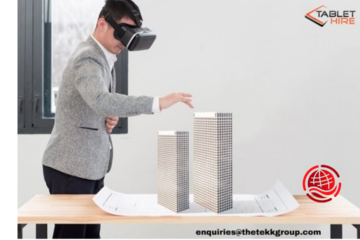Recent years have seen the rise of Augmented Reality. This technology is a game changer in many companies with its ability to combine virtual reality with the real-life environment.
The surge in technological progress and the growing need for augmented reality (AR) integration have positioned AR app development at the forefront of numerous industries’ goals. These sectors are keen on enhancing customer experiences, increasing engagement, and generating innovative concepts.
If you’re a business owner or an aspiring entrepreneur, and you’re planning to invest in this incredible technology, you should partner with any trusted AR app development company today.
This detailed guide will cover the critical aspects of creating an AR app, exploring its benefits, limitations, and the future possibilities of this intriguing technology.
Understanding Augmented Reality (AR)
Augmented reality is a technology that provides a virtual experience by combining the real world with digital information, such as images, videos, or 3d models. Unlike VR, which creates an entirely digital immersive environment built from scratch, AR adds virtual elements to the pre-existing physical environment. AR technology can be utilized across various devices, including smartphones, tablets, smart glasses, and headsets, making it accessible for a wide range of users to engage with.
The Evolution of AR Technology
Over time, AR app development has undergone transformative changes driven by technological advancements and a rising appetite for interactive experiences. Initially, AR applications focused on essential functions like AR filters and straightforward games. Nevertheless, due to the increasing processing power of devices and the development of more efficient tools, developers can now develop AR applications with extra advanced functionality compared to old-time apps. If you want to learn more about an AR zone app in detail, our following blog post will assist you.
Critical Components of AR App Development
Tracking Technology
Tracking technology is one of the most common features of AR app development, so you can think of it as the app’s ability to read and understand the physical world around it. Several tracking methods, such as marker-based tracking, markerless tracking, and SLAM (Simultaneous Localization and Mapping) technologies, have been introduced, and each one has unique advantages and shortcomings.
User Interface (UI) Design
The crucial element of AR apps is an intuitive and user-friendly interface that enables easy application interaction. The UI design in AR apps primarily involves integrating virtual elements into the real-world setting to feel authentic and enhance user engagement with their surroundings.
3D Modeling and Animation
Enhancing the performance of an AR application hinges on developing superior 3D modelling and animation. The primary focus here is on using software to create and animate virtual objects that developers then integrate into real-world settings.
Integration with External APIs
AR applications depend on essential APIs to integrate various external resources, from location tracking to object recognition and live data updates. This integration expands the app’s functionality and offers users more tailored experiences.
Benefits of AR App Development
Here are some of the most common benefits of AR app development.
Enhanced User Engagement
Compared to traditional apps, AR apps generate more immersive and interactive user experiences, increasing user retention and engagement rates.
For example, the use of AR in marketing campaigns can result in the creation of interactive advertisements. This means it will allow consumers to engage with the product in a new and exciting way that reinforces customer retention and brand recall.
Increased Brand Visibility
Brands can now create an app that uses AR technology to give their customers a one-of-compelling or mind-blowing experience, directly increasing brand awareness and loyalty.
For instance, AR technology can create a virtual fitting experience for fashion brands. It offers a visual of clothes or accessories, inferring to the customers how the apparel or accessories appear on themselves before buying the products.
Enhanced Shopping Experience
Lately, augmented reality (AR) has transformed how people shop; they can know what products look like or fit in their spaces before purchasing, so sales increase through better decision-making.
For example, furniture retailers’ showrooms can create an AR app to enable customers to see any furniture in their homes before paying for it.
Increased Sales and Revenue
Companies can employ AR apps to bring about a new shopping experience that is interactive and personal to the customer, thereby enhancing the company’s sales and revenue.
For instance, beauty product companies may do this by using augmented reality apps, enabling customers to preview their makeovers virtually, thus increasing sales.
Challenges and Considerations in AR App Development
Hardware Limitations
The device must have sufficient processing power and sensors for an app to run smoothly. A significant challenge for developers is ensuring their apps are well-suited to various devices.
Nonetheless, the problem will likely be diminished as technological advancement progresses.
User Experience Design
The nature of assembling consequential and easy-to-use AR interfaces requires the thoughtful study of technology and the behaviour of humans, who may be prone to complex issues and processes.
Developers must consider user interactions, spatial awareness, and visual design to develop an awe-inspiring AR experience.
Content Creation
Creating 3D models and animations of high quality for an AR app may cost a lot and require a long time, especially when the application is not easy.
Secondly, without optimizing the content for AR, developers might end up with poor performance on a range of devices due to the additional resources needed for AR.
Privacy and Security
Integration of AR apps could arguably lead to privacy and security concerns as these applications typically seek user permission to access sensitive data, e.g., location data and camera feeds, among several others.
Developers have the task of taking the security of user’s data very seriously and following stipulated regulatory requirements to comply with all the relevant regulations.
Integration with Existing Systems
However, incorporating AR apps with in-style systems and technologies may face some challenges, especially in the case of a problematic enterprise environment setup. Developers should be meticulous to ensure the mobility and integration of the end system to the backend database is smooth for user experience.
Final Thoughts
AR app development has advanced significantly, unlocking unprecedented possibilities for businesses and consumers alike. Beyond the technology that blends virtual and real worlds, AR can transform various sectors, notably gaming, retail, education, and healthcare.
The more technology progresses, the better and more realistic AR experiences will emerge, inevitably changing our relationship with the physical world. Partner with any leading app development company and get your AR app developed today.
Author Bio
Mohammad Asif, who excels as both a mobile app developer and content writer at Trango Tech, skillfully combines his knowledge in these areas to develop apps that are high in performance and centered around the user. His programming is marked by cleanliness and efficiency, complementing his ability to produce precise, concise, and captivating writing. Asif constantly updates himself with the newest technologies and trends, ensuring his applications remain cutting-edge. His dedication to enhancing user experience is evident in all his work, establishing him as a highly valued professional in the mobile app development sector.



